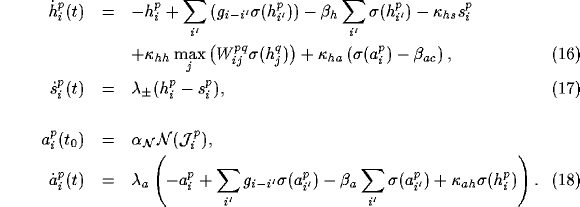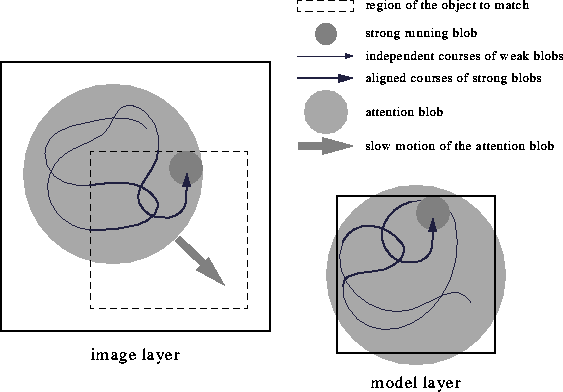



The alignment between the running blobs depends very much on the constraints, i.e., on the size and format of the layer on which they are running. This causes a problem, since the image and the models have different sizes. We have therefore introduced an attention blob which restricts the movement of the running blob on the image layer to a region of about the same size as that of the model layers. Each of the model layers also has the same attention blob to keep the conditions for their running blobs similar to that in the image layer. This is important for the alignment. The attention blob restricts the region for the running blob, but it can be shifted by the latter into a region where input is especially large and favors activity. The attention blob therefore automatically aligns with the actual face position (see Figures 6, 7 and Movie 2). The attention blob layer is initialized with a primitive segmentation cue, in this case the norm of the respective jets [19], since the norm indicates the presence of textures of high contrast. The corresponding equations are (cf. Equations 1 and 5):

The equations show that the attention blob  is generated by the
same dynamics as was discussed in the Blob Formation section for
the formation of the running blob without delayed self-inhibition,
though since the attention blob is to be larger than the running
blob,
is generated by the
same dynamics as was discussed in the Blob Formation section for
the formation of the running blob without delayed self-inhibition,
though since the attention blob is to be larger than the running
blob,  has to be smaller than
has to be smaller than  . The attention
blob restricts the region for the running blob via the term
. The attention
blob restricts the region for the running blob via the term
 , which
is an excitatory blob
, which
is an excitatory blob  compensating the constant
inhibition
compensating the constant
inhibition  . The attention blob on the other hand gets
excitatory input
. The attention blob on the other hand gets
excitatory input  from the running
blob. By this means the running blob can slowly shift the attention
blob into its favored region. The dynamics of the attention blob has
to be slower than that of the running blob; this is controlled by a
value
from the running
blob. By this means the running blob can slowly shift the attention
blob into its favored region. The dynamics of the attention blob has
to be slower than that of the running blob; this is controlled by a
value  .
.  is the norm of the jets, and
is the norm of the jets, and  determines the initialization strength.
determines the initialization strength.

Figure 6: Schematic of the attention
blob's function. The attention blob restricts the region in which
the running blob can move. The attention blob, on the other hand,
receives input from the running blob. That input will be strong in
regions where the blobs in both layers cooperate and weak where they
do not (see Figure 4). Due to this
interaction the attention blob slowly moves to the correct region
indicated by the square made of dashed lines. The attention blob in
the model layer is required to keep the conditions for the running
blobs symmetrical.

Figure 7: (click on the image to view a larger version)Function of the attention blob,
using an extreme example of an initial attention blob manually
misplaced for demonstration. At t=150 the two running blobs ran
synchronously for a while, and the attention blob has a long tail.
The blobs then lost alignment again. From t=500 on, the running
blobs remained synchronous, and eventually the attention blob aligned
with the correct face position, indicated by a square made of dashed
lines. The attention blob moves slowly compared to the small running
blob, as it is not driven by self-inhibition (cf. Movie 2). Without an attention blob the
two running blobs may synchronize sooner, but the alignment will
never become stable (see Movie 3).
Movie 2: Attention blob dynamics as in Figure 7. We see here the running blob (black), the delayed self-inhibition (red), and the attention blob (blue) on the image and the model layer (336 kB).
Movie 3: Blob dynamics as in Movie 2, but without attention blobs, demonstrating that alignment does not get stable (196 kB).


